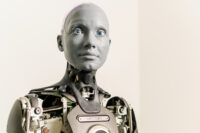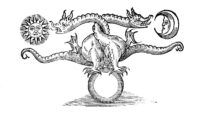Being born is choiceless, but fairly soon thereafter we begin to choose. The choices we make follow the branching structure of time, each moment of choosing akin to a bud on a twig that either begins to grow or withers away.
As living beings, we are semi-autonomous vehicles, our sensory apparatus constantly receiving and gathering information about what’s going on around us and prompting moment to moment inferences and adjustments to our choices, decisions, and actions. If the traffic light is red, we stop. When it turns green, we go. In many ways the choices we make seem almost machine-like, using information to establish probabilities to anticipate outcomes; no wonder we’re prompted to create self-driving vehicles.
Self-conveyed minds make choices all the time. Sometimes my mind decides to take “me” for a walk, for example. Using an internalized map of the world and its data to navigate, my mind’s “I” visualizes a path to follow while my personality, exercising its will in fulfilling its survival instinct, thinks about lunch and its probabilities.
If I have food in the refrigerator, do I have any interest in preparing it? If the answer is “no,” then do I want have lunch somewhere else? If the answer is “yes,” then do I know where I would like me to go? If the answer is once again “yes,” then do I have money in my pocket? So it goes. This yes/no-if/then process proceeds until my personal choices and my appetite are fulfilled. Most of the day consists of these sorts of branched decisions, one following the other in a series of unspoken, and quite often less-than-conscious, internal dialogues.
Our hard-wired survival algorithm is quite straightforward and unwavering: we do what must be done in order to continue to be. Pattern recognition and making choices seems reducible to a formulaic binary approach of posing yes/no questions and offering if/then choices; we’re a species of non-artificial intelligence. If Intelligence is simply a matter of collecting and ordering information to support making choices, it easily leads to the conclusion that the more information accumulated, the greater the intelligence. That assumption is driving the development of AI, but prompts an essential question: does greater intelligence produce greater wisdom or even any wisdom at all?
For each of us, wisdom seems to come in two flavors: embodied and acquired. Embodied wisdom is choice-less. When “I” take “me” for a walk, “I” doesn’t need to choose each step before “me” takes it. The same is true for swallowing; I don’t have to choose how to swallow, or for that matter, how to breathe or digest my lunch. Most of the embodied processes of life are autonomically self-regulating in this way, wisdom proceeding without requiring any conscious participation or decision-making at all.
Acquired wisdom, on the other hand, consciously emerges when a given moment we encounter varies from what we anticipate and thereby causes a shift of inference in probabilities of outcome. When the product of sudden intuitive insight or thought, such moments alter and update our internal inferential map; these are the “Eureka!” moments when mind’s internal “light bulb” turns on. Emergent wisdom is not always the product of rational or linear thought, but often emerges as irrational or holistic awareness, the gestalt of a moment.
In this way, acquired wisdom is enlightenment, the illumination that changes everything, if only for a second.






Be First to Comment